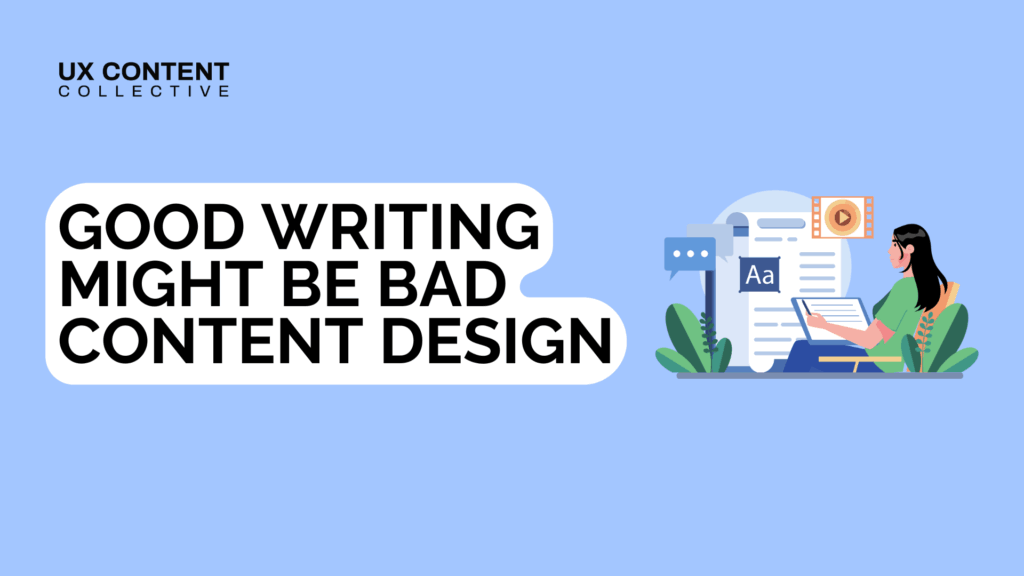
Good writing might be bad content design
Michael Restiano

Ready to advance your UX content skills?
Take the next step for content designers and UX writers: enroll in Advanced UX Content for Product.

I hate using reductive words like “good” and “bad” along with a catchy, paradoxical headline, but hey, it got you here reading, didn’t it?
But, in all seriousness: I have been in content design for more than a decade, and for more than half of that time as a people manager and leader. I have hired and partnered with some absolutely amazing, stellar writers during that time. I’m talking about people who knew AP style like the back of their hand, had very strong opinions about the Oxford comma, and could spend days-on-end writing the perfect, most effective string for a product.
In many (but certainly not all!) cases, these folks struggled to have as much impact as peers who didn’t share their impressive editorial attention-to-detail. And that sort of seems unfair, right? You’d think the people who spent the most time obsessing about good writing would be the ones to deliver the best, most impactful results. So what gives?
Well, let me give you my personal take.
Content designers work for businesses; not publications
And in most cases, those businesses do not care about editorial excellence. They understand the value of having clear, user-focused, helpful product copy of course (they wouldn’t hire us if they didn’t!) but I think you’d be hard-pressed to find a Chief Product Officer who thought non-compliance with the Oxford comma was a P0 product issue that needed to be fixed asap.
Folks at the top of these businesses care about, well, business metrics. Things like revenue, churn, and profit. And while there are many cases in which doing something like selecting the right button copy drives a significant amount of incremental revenue, by-and-large, editorial minutiae does not have direct, material impact on business metrics.
Please don’t misunderstand me here—I am not saying that product content is not important and does not contribute to business metrics. It is absolutely essential that companies create interfaces that are easy-to-use and user-centric.
But what I AM saying, is that the smaller bits of product content—the “is it a comma or an em-dash” dilemma, the one-off use of title case instead of sentence case, and yes—even the dreaded typo— do not usually hit the business’s bottom-line that hard.
These are quality considerations. Things that we care about as content designers because we care a lot about our craft. And I hope that we continue to care about and take care of those details, too! I’m not advocating for letting the typo ship or just generally doing sloppy work.
Does “good writing” have the most impact?
If one of my reports spent weeks developing an iron-clad content strategy and getting buy-in to it from their design, marketing, and product partners, but then accidentally shipped the wrong button casing when it came time to do the writing, I truly wouldn’t care. I’d ask them to file a quality ticket, sure, but I wouldn’t give them harsh feedback or hold it against them in a performance review.
Because they spent their time where it actually mattered—getting the rest of their team bought into the high-level, strategic implications of their work.
Long ago when content design didn’t exist and we were known mostly as “content strategy,” nearly all of the work we did was higher-level and non-executional. We created guidelines, frameworks, and plans far more often than we ever took pen to paper to create a UX string. I remember during my first job in content at SapientNitro, I wanted to provide some example product strings to an Ecommerce client of mine. My manager (and her manager) both told me, politely, “we don’t do that, the copywriters do.” I thought it was bonkers at the time, but a decade later, I see what they meant.
Our field has over-pivoted into execution, to a degree. We’ve forgotten that the true magic and value of our work has never been the actual creation of good writing in the interface, but all the thinking and processes that lead up to the creation of those words.
And if you think this is just me waxing poetic about the past for no reason, please think again.
Generative AI will make us all into strategists again
I also hate making predictions about the future (nobody actually knows what’s going to happen and if they’re trying to convince you they do, they want to sell you something) but I do feel pretty strongly about this one.
Generative AI and LLMs have shown us that execution (aka, the writing itself) can be automated. Sure, these models don’t produce quality content that’s entirely ready-to-go from the jump, but one day, they might.
And that doesn’t mean content design is #over or that it’s the end-of-the-line for this field—it is an invitation for all of us to get back, ironically, to where we began: the strategic considerations that actually matter to the business.
Because ultimately, yes—anybody can prompt a model and get some strings. But only people who have immersed themselves in this work for years have refined enough tastebuds to determine what’s actually “good writing” and what’s just generic robot-speak. And only a human being can conduct all the alignment conversations that result in those refined words ultimately making it into the product.
That, my friend, is you! And if you are spending your time acting as a strategist and not just an executor, no AI can ever replace you.
How to spend your time strategically
Really get to know your user. And I mean the way you know your best friend or a family member. That kind of deep, intimate knowledge doesn’t happen when you watch a few transcripts of past user-research. It happens when you get out into the field yourself and take an active interest in these people. Learn what makes them tick, what they’re afraid of, and the language they already use to talk about their needs.
Spend lots of time with your cross-functional peers.
- Are you aligned, at a high-level, about what the message you’ll design needs to say?
- Have you given your feedback on what the container of that message may or may not be?
- Do you know if there will be external comms that carry that same message outside of the product?
- If so, what are they and who’s receiving them?
Remember, you all work for the same company, and that company should only have a singular voice. It takes quite a bit of time to align that across rolls, channels, and launches!
Become an expert in generative AI and LLM usage. Because for better or worse, these tools are here to stay, and increasingly companies want content designers who know how to train them, use them, and optimize their outputs. Again, that is not a replacement for your existence or your work, it is an enhancement to your executional efficiency.
Design your message efficiently. If you spend most of your time doing the above things really, really well, this part of the process should be a lot quicker than you think. It starts with a good prompt to your LLM of choice and ends with you massaging an output into a message that does everything you need it to do and that the team can get behind.
Note that I did not say the “perfect” message. There is no “perfect” message. The goal is to get something you feel reasonably confident about into the product.
After that’s done, then you can test and learn, tweak and fiddle, and take all those important quality considerations into account.
Michael Restiano is the Head of Content Design at Webflow. Connect with him on LinkedIn.



